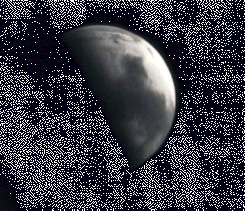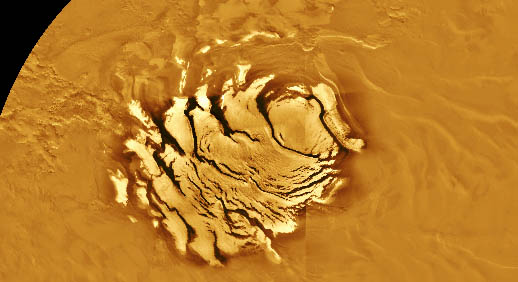
 |
 Photograph of Mars, taken by Mars Observer in August 1993. 10. A Martian History We'll conclude by speculating about Martian history. The details are few and fragmented, but perhaps something can be pieced together. One event certainly stands out: Martian civilization has collapsed. There is no sign of technological civilization on Mars today, apparently no Martians visiting Earth. At some point, there must have been a devastating event that wiped their world clean of technological civilization. And this disaster must have happened before the Cydonia Complex was constructed. The moons had to be orbited before the complex could be built, but the complex never would have been built unless somehow scientific knowledge had regressed back to paganism. So: cosmic disaster first, Cydonia Complex after. There must have been a First Era Civilization, which captured the moons and visited Earth. Then came the Collapse. During the Second Era Civilization, the Cydonia Complex was built. The genealogies in the Bible enable us to construct a chronology. Working backward from secular historical events, the year of the Flood can be calculated at 2459 BC.[1] No later than this, the Nephilim arrived on Mars and First Era Civilization began. Sumerian records place first contact with the 'Anunnaki' -- the Nephilim/Martians -- before 2000 BC. Biblical references of Arba, father of Anak (who in turn was father of the Canaanite Nephilim), point to the same timeframe. First Era Civilization had reached its zenith by then. Then comes the Collapse. Contacts with Sumeria cease, the Martian astronauts are stranded on Earth and interbreed with the population, their descendants migrating to Canaan. By 1500 BC, these descendants have reverted technologically, so that bronze-age Israelites can conquer them. The Collapse must come before 1500 BC. The Collapse must have occured shortly after the moons were pushed into orbit. There are no signs of construction work on the moon surfaces. The coincidence in timing suggests that the moon placement and the Collapse were somehow related. The Collapse may have involved a massive meteor bombardment. We don't see cities on Mars, but we do see lots of meteor craters, so many that evolutionists confuse this calamity with planetary accretion itself. Intense meteor bombardment would vaporize the Great Ocean of Mars. With the weight of so much water lifted so rapidly, the planetary crust would convulse in earthquakes. Superheated steam would blast over the land. It would be devastating to Martian civilization. And what was left after the Collapse? Surely only a handful of Martians survived. For such complete technological forgetfulness between First and Second Era Civilizations, the Collapse must have been as nearly global in destruction as the Great Flood of Noah. And to have annihilated the Martians so thoroughly, the Collapse must have caught them by surprise. Even a few hours warning should have allowed thousands of Martians to escape. They didn't even have that. After the Collapse, the handful established Second Era Civilization. Their descendants numbered in the millions, and spread across the whole face of Mars. But the glory of Martian scientific achievement was past. Out of their ignorance came the Cydonia Complex. The Cydonia Complex has a crude look to it that suggests that it was either left unfinished, or damaged and left unrepaired -- as if this is the high point of Martian Second Era Civilization. The Martians themselves seem to have never rebuilt their industrial base, for we see no signs of such technology. Since scientists on Earth speak of using technology to modify the climate on Mars, the Martians would be all the more likely to do so. But the planetary environment remains inhospitably cold and airless. The Mars of the Mariner and Viking probes is a dead world lacking even a breathable atmosphere. If the Martians are still alive, they must be huddled in pressurized caves, and are perhaps few in number. It is a humble end for a race which once seemed bound for the stars.
This speculative history of the Nephilim is indeed grim: Exile, collapse, and then slow death. How could a loving God allow such things? Well, we must recognize that God is loving, but he also enforces his commandments. The calamities of the Nephilim are so great that they must manifest the judgement of God against their entire race. Just as God exiled Adam and Eve from Eden, so he exiled the Nephilim from Earth. Just as he destroyed the first civilization on Earth with the Flood, so he destroyed the First Era Civilization of Mars with the Collapse. Just as he allowed his chosen nation of Israel to decline, so he allowed the Martians to perish as well. The Nephilim were originally exiled from Earth to keep them separated from humans. In returning to Earth during the First Era Civilization period, the Nephilim were violating this divine edict. God allowed some visitation -- but then the Nephilim plainly went too far. The moons explain why. As space stations, they are impractically large for anything other than planetary emmigration. The Martians were planning to place millions of their people into interplanetary space. Was their destination Earth? The ancient Sumerian religious scriptures teach that humanity was created for but a single purpose, to serve the whims of the 'Anunnaki' -- the children of the sky god. Since the Anunnaki are the Martians, the real purpose of this false religion was to brainwash humans into becoming slaves for the Martians. The Martians were coming not just to colonize Earth, but to conquer humanity. This obviously ran counter to God's will. The Nephilim may have been warned more than once, but they persisted. In the end -- judgement by fire. Given the timing and scope of the event, the divine intent seem clear. Surely nothing else but the hand of God could have prevented the Martians from conquest and enslavement of our race. After such a narrow brush with extinction, the Martians might have sought reconciliation with God. Instead, they turned farther away, forgetting him entirely, and worshipping their moons, the relics of their own folly. God could not protect them under the circumstances. Without the Creator's awesome supernatural power to sustain it, the Martian ecosystem started on a long path of deterioration. Every century, Mars became drier and colder and more desolate. Yet, instead of repenting before the one true God, the Martians in their spiritual pride tried ever more furiously to attract the attentions and favors of their imaginary moon gods. The immense civil engineering project effort behind the Cydonia Complex reveals the depths of their misdirected desperation -- which ultimately served to alienate the real God all the more.
This vision of a dying Mars is remarkably in accord with Lowell's canal hypothesis. If Second Era Civilization could have built the Cydonia Complex, then it certainly could have contemplated a worldwide irrigation system such as Lowell depicted in his books. What if Lowell truly did observe Martian canals in operation -- as recently as the late nineteenth century? In the evolutionary timescale, it is improbable even that the lifespan of the human race should coincide with that of the Martian race. In the creationist timescale, especially in the divine intervention of God, it is possible that the Martian ecosystem may have changed dramatically even as we were observing it. Perhaps the Lowellian Mars actually existed in the 1890s. Perhaps the canals were in operation, and the Martian atmosphere was thick enough for water to exist as a liquid. In the 1960s, Mariner IV did not discredit Lowell's observations, it simply showed that Mars had changed since Lowell's day. Astronomers of Lowell's day, many of whom disagreed with Lowell's intelligent life hypothesis, observed fewer and less widespread dust storms, more water clouds, a more stable South Pole ice cap, and higher atmospheric pressures than were measured by space probes since the 1960s. Were these astronomers all misled by 'wishful seeing?' Or did they accurately chart the decline of the Martian ecosystem over the course of the twentieth century? |

| The Incredible Shrinking
South Polar Ice Cap? There is a startling observation that indicates we should take Lowell's canals more seriously. It came from the American astronomer William Pickering in the year 1924. "It is a rather curious coincidence," Pickering wrote, "that at each of the recent very near approaches of the earth to Mars strikingly regular, although only temporary, geometrical figures should have appeared upon its surface."[2] These figures, said the observers, measured hundreds of miles across. Pickering commented on one figure: "Again it was pentagonal, apparently a favorite figure with the supposed Martians . . . . "[3] And yes it is, for a pentagon appears at the Cydonia Complex. In Figure 9, the Cydonia pentagon is compared to Pickering's figure. Figure 9: Pentagons
Pickering's pentagon was first seen in 1894, and not before or since. Rather than a permanent structure, it was more likely composed of dust or plants placed in formation by the Martians. In the early nineteenth century, scientists had proposed planting crops in the form of gigantic geometric figures in order to signal the Martians.[4] Maybe the same idea occurred to the Martians. If so, then Martians had to be alive to plant the figures, in the early twentieth century. Since the figures had to planted in precise locations to be seen from Earth, they were obviously intended for communication. Were the Martians signalling yet another 'god?' Or had they outgrown such pagan nonsense and knew Earth to be inhabited with beings like themselves, possibly their own colonists from millennia before? If the Martians had telescopes, they would see the lights of our growing cities, and they would know we are here.
We've covered some pretty fantastic speculations. Are they likely? That's not the point. Likely or not, when we go to Mars, we'll have to prepare for some once unthinkable possibilities. Will we find only the remains of a pre-industrial civilization no more advanced than ancient Egypt? Or digging deeper, will we find buried relics of a civilization more technologically sophisticated than our own? Will we find the Martian race extinct? Or will there be teeming underground cities of millions? Will the Martians be peace-loving and friendly -- or will they conform to the biblical chronicle of a race bent on violence and enslavement of humanity, and so demonically dominated that God once ordered even their children to be put to death? Will their most advanced weapon be the bow and arrow -- or the atomic bomb? There are disturbing questions that can only be answered by a vigorous program of exploration of the planet Mars. We must go and see. |